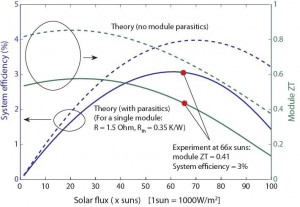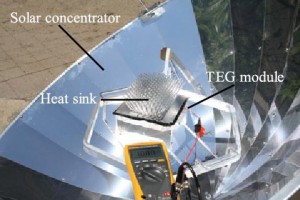Solar Thermoelectric Generator
Historically, thermoelectrics have been used primarily for deep-space exploration and waste-heat recovery. We explore the potential of thermoelectrics with solar energy for electricity generation. Direct solar-to-electrical energy conversion is possible with a solar thermoelectric generator (STG) (Figure 1). STGs employing cheap parabolic light concentrators and high-ZT thermoelectric materials are an attractive alternative to solar photovoltaics for micro-power applications. Earlier work on STG [1] [2] [3] has shown low system efficiency (<1%) primarily due to small-module ZT and low solar concentration. With solar concentration of 66x suns, a system efficiency of 3% was measured for a commercial bismuth telluride (Bi2Te3) module with the output power of 1.8W [4]. A thermodynamic analysis based on energy balance and heat transfer is used for predicting the thermal-to-electrical conversion efficiency for the generator (Figure 2). For radiative loss suppression, a “selective surface” coating is utilized which has large absorbance (0.88-0.95) near the visible wavelength (400-1200nm) and low emissivity (0.2-0.4) at wavelengths above 2.2 mm.

Figure 2: Theoretical simulation for Bi2Te3 showing module ZT and system efficiency: Without any parasitic, maximum system efficiency of 4% is achieved at 70x suns. The model is verified with an experiment at 66x suns. Parasitics are included in the theory to represent the commercial module.
The bulk retail price for a 15W thermoelectric generator is $25, giving the peak power price of $1.67/Wp, where-as the retail price for a PV module is $4/Wp. We compute the electricity price (cents/kW hr) for the STG by calculating the total amount of electrical power generated within the lifetime of a generator (20 years). The electricity price for STG is within 20-35 cents/kW hr and that for commercial PV is 20-26 cents/kW hr. With better module design and use of materials with better thermoelectric properties at higher temperature, solar thermoelectrics can be economically competitive with small-scale PV power generation for many applications such as rural electrification in developing countries and power supply for remote sensors. We are working with a non-governmental organization (One Earth Design), to deploy thermoelectric generators as a part of Sol-Source 3-1 for solar cooking, heating and electricity generation for remote villages in rural Western China.
References
- M. Telkes, “Solar Thermoelectric Generators,” Journal of Applied Physics, vol. 25, no. 6, pp. 765-777, June 1954. [↩]
- N. Vatcharasanthien, J. Hirunlabh, J. Khedari, and M. Daguenet, “Design and analysis of solar thermoelectric power generation system,” International Journal of Sustainable Energy, vol. 24, no. 3, September 2005. [↩]
- S.A. Omer, and D.G. Infield, “Design optimization of thermoelectric devices for solar power generation,” Solar Energy Materials and Solar Cells, vol. 53, pp. 67-82, January 1998. [↩]
- R. Amatya, and R.J. Ram, “Solar Thermoelectric Generator for Micropower Applications,” Journal of Electronic Materials, April 2010. [↩]
